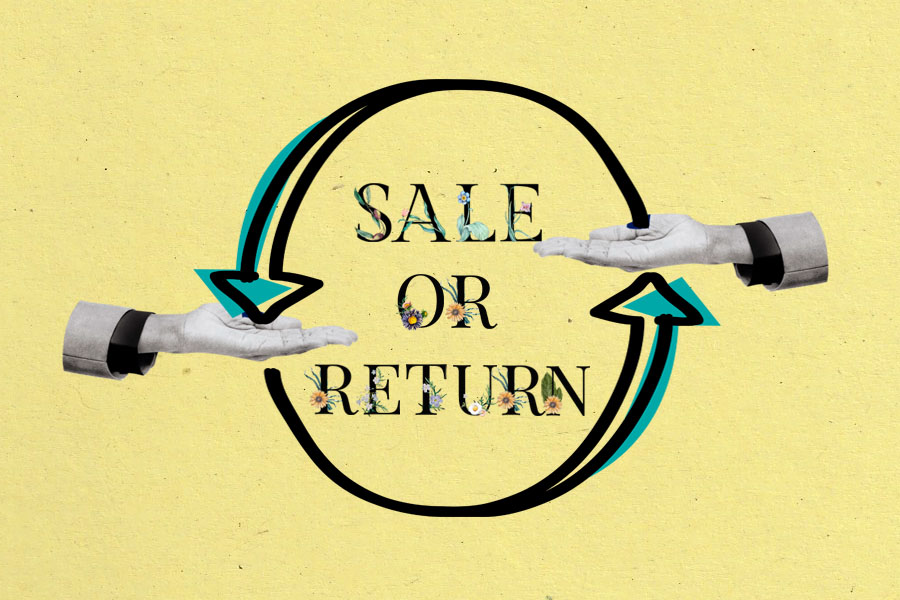If you are a designer, an artist or sell lifestyle products to independent shops or galleries, you have probably come across the sale or return arrangement. As retail has been evolving so has its playing field and terms. Flexibility, low risk and low stock investment are three benefits that most modern-day retailers seek in partnerships. And sale or return is one of them.
What is sale or return?
Sale or return is an arrangement under which your products can be kept by the potential buyer (a shop or a gallery) for an agreed period while they try to sale it. If they don’t sell the products, they return them to you and only pay for products that they sold on your behalf.
While sale or return agreement seems to be the easiest and risk-free solution for retailers, it may not the best solution for brands, designers or artists on the other side of it.
How to approach sale or return negotiations
Generally speaking, I think that sale or return is NOT a win-win solution for both parties. The obvious question is: If a retailer has no financial commitment, and haven’t invested into purchasing the stock, how much incentive does he have to make sales for me?
What seems to be happening is that retailers are happy to “test” various products to see “if” they sell. Risk-free. So how can you benefit from this? If the retailer is not proactive in selling your products, meaning actively promoting and introducing them to customers, or doesn’t really understand your brand story, you could end up with returned (even damaged) products.
So, what is the solution?
There are many options but first of all you need to understand the retailer’s business and their ability to sell. This can be very tricky because everyone wants to “look good”. They might tell you white lies because they like your product. They might not be completely honest in order to get what they want. Negotiating skills, following your gut and some previous experience all help you to decide whether or not it’s worth doing business together.
TEST THROUGH A TRIAL PERIOD
If sales or return agreement is the only option on the table suggest a trial period (between 3-6 months), which both parties are happy with. That way you will provide enough time for the retailer to do their work. They will have to have some incentives, either from you or themselves, to actually deliver your expectations. Perhaps suggest that within the trial period you would expect X amount of sales, based on the information they provided. Of course, there are no guarantees but it puts a certain pressure on them. If they don’t deliver you simply take your business elsewhere.
OFFER INCENTIVES
Talking about incentives, perhaps suggest an additional benefit which will encourage the retailer work harder for you. It can be an extra discount once they hit certain amount or volume. It could be sharing costs of promotional materials or advertising, or offering free delivery on orders over a certain amount. You can only decide on the best incentive once you find out what makes them tick. Are they driven by bigger margins, higher volume sales or less extra costs?
MAKE SALE OR RETURN AN UNATTRACTIVE PROPOSITION
This one, I think, will really test your negotiating skills. What do I mean by making sale or return unattractive? This negotiation strategy will probably apply only to situations where you know for certain that the retailer wants your product quite desperately – where your product can really help the retailer’s business.
If you spot this opportunity, you have some serious room for negotiating. Suggest that you have two pricing structures – one is for sale or return and the other is for (traditional) wholesale. The difference between the two would have to be such that sale or return wouldn’t make sense.
For example, sale or return could require a deposit to cover any damage while in their care and during transport. Also, you could charge an admin fee and postage for returned stock, and/or require collection and delivery from and to your warehouse. Why should you be the one who takes the hit and cover the extra costs when they don’t even buy the product? On the other hand, you can offer much better terms, the wholesale option.
What should you cover in sale or return agreement?
Sale or return problems usually occur when a clear agreement is not in place. Always ensure that you have every little detail agreed in writing. This includes:
How many items or products are part of this agreement?
How long will the products be with the retailer?
Who covers responsibility and cost of damaged or stolen products?
Who is going to be responsible for the insurance while in the retailer’s care?
What happens if the retailer goes bust?
What are the payment terms and trade discounts or commission rates?
What is the marketing plan and specific promotional activities?
Points to remember:
When it comes to independent retailers, some of them might be just starting out, and so not all of them know how to trade and sell well. Most comply to the standard trading terms, which can be easily found, whether that’s through online searches or networking. They work with the same margins, have same demands and most feel that they are doing you a favour.
On the other hand, big retailers will try to bring you to your bottom line. You need to evaluate each opportunity and decide, based on your expectations – sales, exposure, brand awareness – whether or not they are right for your business. You should always strive to create win-win situations. If they approach each supplier in a same way and have demands which are not win – win in your eyes, don’t be afraid to walk away.
The good thing is that right now there are new businesses popping up everywhere. You might feel you’re missing out but trust me, there are many others who are hungry to do business with you.
So to sum up, here are some dos and don’ts when it comes to sale or return arrangement.
The dos:
- Be flexible and adjust your terms to each situation, if necessary.
- Know your bottom line and expectations.
- Understand the retailer’s business.
- Be proactive and check in with retailers regularly to spot any sales or needs they may have.
- Visit the shop or gallery in person on regular basis to build a better relationship.
- Ask the stupidest questions in order to get the information you need.
- Always strive for win-wins.
The don’ts:
- Don’t be afraid to create your own terms.
- Don’t accept win-lose terms.
- Don’t rely on the retailer and hope for sales. Offer your support and educate them. Become their best supplier.
- Don’t be afraid of missing out on opportunities. Better ones are just around the corner.
In conclusion, sale or return can work for your brand and products even without generating massive sales. To see if this type of arrangement is good for your business, you need to evaluate the benefits that it can bring. If brand exposure and product visibility – meaning having them somewhere physically on display and in the shop window are more important than sales, then this type of arrangement can work for you very well.
However, if you want to build a network of shops, galleries and stockists who are passionate about your brand – who you are, your story and what you offer, then sale or return may not be the best route for you to grow your presence and visibility on the high street.
Inside our KNOWLEDGE SHARE membership we delve into specific ideas covering each area in much more detail, giving you the tools, templates and processes which you can apply in your business straightaway. If you want to find out about it more, please click or tap here.
Recommended further reading: How to sell to retail by Clare Rayner
Transparency Disclosure: This post may contain an affiliate link and we may receive small commission if you decide to make a purchase of this book. We only recommend books our team believes are of highest quality, relevancy to your creative business and value to your brand.










